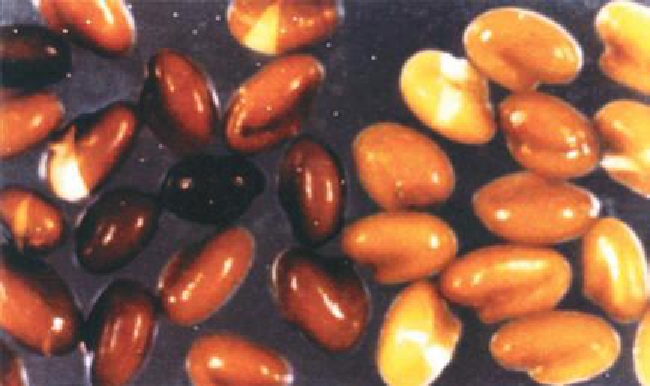Agriculture Reference
In-Depth Information
Procedure
1. Add 3.0 g of cupric sulfate (CuSO
4
) to 30 ml of household ammonia (NH
4
OH) in a stoppered
bottle.
2. After mixing, a light blue precipitate (cupric hydroxide) should form. If no precipitate forms, add
additional CuSO
4
until a precipitate appears. Since the strength of household ammonia can vary,
this procedure insures that a complete reaction takes place between CuSO
4
and NH
4
OH; other-
wise, fumes from excess ammonium hydroxide may cause eye irritation.
3. Scratch the seed coats of the sweetclover seeds being tested to insure imbibition.
4. Imbibe the seeds in water for 2 to 5 h in a glass container.
5. When the seeds have imbibed, remove excess water and add enough copper sulfate-ammonia
solution to cover the seeds.
6. After staining for 10 to 20 min, yellow sweetclover seed coats will stain dark brown or black and
white sweetclover seed coats will stain olive or green (Fig. 9.7).
Figure 9.7. The copper sulfate-ammonia test for sweetclover: Yellow sweetclover (left), and white-blossom
sweetclover (right).
oat (
Avena
spp.) Seed fluorescence Test
The oat (
Avena sativa
L.) seed luorescence test is listed as a variety testing procedure in the AOSA rules
and the AOSA Cultivar Purity Testing Handbook. This procedure distinguishes between white (luorescent)
and yellow (nonluorescent) oat seeds (Fig. 9.8).
Procedure
1. Place the seeds to be tested on a black background. A minimum of 400 seeds is required.
2. Evaluate the seeds for luorescence under black light such as 15 watt blacklight tubes in a room
from which all other sources of light are excluded.
3. Seeds are considered luorescent if the lemma or palea luoresce or appear light in color. Partially
luorescent seeds should be considered luorescent. Seeds are considered nonluorescent if the
lemma and palea do not luoresce and appear dark in color.

